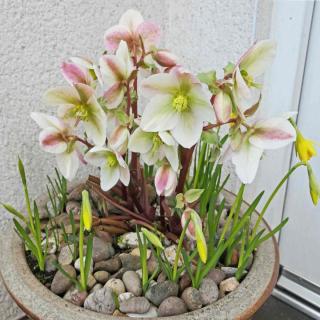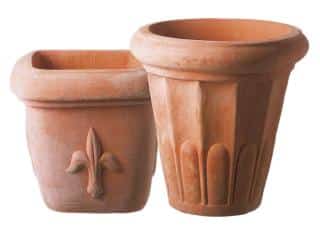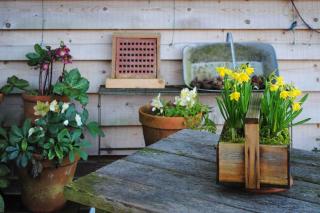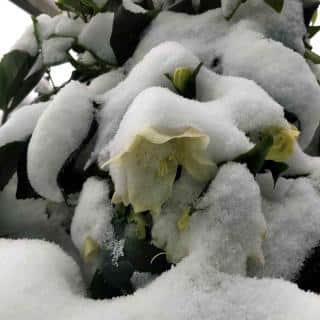

Growing a hellebore in a pot makes it possible to witness its exceptional winter blooming even without a garden.
Indeed, hellebore is ideally suited for this purpose: it is very easy to grow all year long in a large container. Great to decorate your terrace or balcony!
However, there are a few rules to follow to make sure they last for years.
 All hellebores, generally, cope very well with growing in pots. Some species and varieties are tried-and-true for growing in containers, among which you’ll find the following:
All hellebores, generally, cope very well with growing in pots. Some species and varieties are tried-and-true for growing in containers, among which you’ll find the following:
 Choosing the pot, for this plant, is the most crucial aspect. Indeed, hellebore hates being moved around from one pot to the next. This is due to their complex and deep-running rhizome root system. Roots usually inch their way straight down, and in the ground they easily make it to 2 feet deep (60cm). They reach to that depth to find cool soil, which is what the plant needs to survive.
Choosing the pot, for this plant, is the most crucial aspect. Indeed, hellebore hates being moved around from one pot to the next. This is due to their complex and deep-running rhizome root system. Roots usually inch their way straight down, and in the ground they easily make it to 2 feet deep (60cm). They reach to that depth to find cool soil, which is what the plant needs to survive.
As a conclusion, best is to go for a pot that’s 2 feet deep (60cm) at least. For the width of the pot, select one that’ 3 to 4 times wider across than the nursery pot you bought them in (assuming you bought yours in a garden store).
 In pots, as is the case in the ground, hellebore requires rich, cool and well-drained soil.
In pots, as is the case in the ground, hellebore requires rich, cool and well-drained soil.
This plant also likes soil that tends to be acidic. Use any leftover peat from your heath plants. Consider pairing your hellebore with heather and other such plants.
Select a mix of garden soil and soil mix upon planting.
Adding fertilizer will be necessary on a regular basis, since nutrients tend to wash out faster when the substrate is in pots.
Note that hellebore, even when growing in a garden box, thrive most when they grow outdoors.
We’ve shared earlier that hellebore hates being transplanted. Best avoid transferring the plant from one pot to another once it has already spread its roots out. Water regularly to ensure that the root clump stays cool all the time. And even though you should avoid having the substrate dry out, also make sure to not drown your plant in water every time you water.
Lastly, the substrate needs to stay rich. Add organic matter every spring. Following these rules will give your potted hellebore the best possible environment, and your plant will thrive without any problems for at least four years. When the plant turns 4 years old, divide it:
 do this in September, without removing the plant from its pot. Simply cut the plant in half, and tease one half out while leaving the other half in place.
do this in September, without removing the plant from its pot. Simply cut the plant in half, and tease one half out while leaving the other half in place.This way, you’ll replenish nutrients in the substrate. Though hellebore should cope quite well with such a division, it’s best to water once a week for a month to make sure roots recover and start spreading again.
Even though it’s very hardy, you’ll do good to protect your hellebore in pots from cold winds and frost if it lasts a long time.
To learn more, read: